Rarities from the New Bedford Museum of Glass
By Kirk J. Nelson
Two years ago a new glass museum opened to the public in New Bedford, Massachusetts. Its permanent collection covers the history of glass from Classical antiquity to the present and numbers more than 7,000 items. The collection includes art glass made in New Bedford by the Mt. Washington and Pairpoint factories, glass from the Midwest and other regions of the country, English and Continental glass, ancient glass dating back to 600 BC, historical glass, Tiffany and Steuben, paperweights, Sandwich glass, contemporary studio glass, and much more. Also on view are glassmaking tools, shards excavated from the Pairpoint factory site, and an extensive, long-term loan display of glass from the collection of the Bennington Musuem, of Bennington, Vermont. The museum’s research library, the largest of its kind in New England, holds 9,500 publications about glass and glassmaking.
The new glass museum originally was incorporated in 1993 as the Glass Art Center, and was affiliated with Bradford College in Bradford, Massachusetts. Following the closing of the college in 2000, the museum began its search for a new home. In 2005 New Bedford glass authority Louis. O. St. Aubin, Jr., suggested that it relocate to New Bedford, where an extensive glass industry had flourished in the late 19th and early 20th centuries. The museum opened a small development office on North Water Street, changed its name to the New Bedford Museum of Glass, and welcomed local residents and collectors from across the country to join the exciting project. The late Kenneth M. Wilson, former Chief Curator of the Corning Museum of Glass, served as Vice President for several years prior to his passing in 2005. The writer of this article, Kirk Nelson, who served as former Curator of Glass at the Sandwich Glass Museum and former Curator of Art and Decorative Arts at the Bennington Museum, was a founding trustee of the new museum and currently serves as President and Executive Director.
In 2009 NBMOG was invited by Jeff Costa, owner of the New Bedford Antiques Center, to establish its galleries and museum shop in a shared factory building space at 61 Wamsutta Street, located about two miles from downtown New Bedford. Renovation of the space began immediately, and the museum’s grand opening celebration took place in September of 2010. Since that time the museum has continued to develop its collection, refine its gallery displays, and organize educational programs for local residents and an international community of glass collectors. Last year the museum hosted seminars for the Antique Glass Salt and Sugar Shaker Club and the Mt. Washington & Pairpoint Glass Society. This spring (May 8th-10th), the museum will host a combined seminar for the National American Glass Club and the Mt. Washington & Pairpoint Glass Society. Registration information is available on the museum’s website http://www.nbmog.org.
The items featured in this article do not necessarily represent the most important examples from the NBMOG collection, although each is exceptional for a variety of reasons. They were chosen to suggest the diversity and quality of the museum’s collection. Additionally, the selected items are all recent acquisitions or have not been featured extensively in the museum’s publications. We hope that they will serve as an enticement for you to visit New Bedford and discover the many other vitreous wonders that await you here!
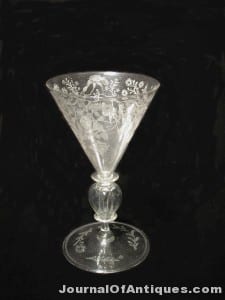
Holland, circa 1680
Height: 6 inches
This delicate wineglass dates to the late 17th century and features an elaborate diamond-point engraved decoration of scrolling vines and flowers, with three bird motifs spaced around the bowl. The glass is light in weight and blown in the Venetian style (façon de Venise), but the engraving indicates Dutch origin. This particular wineglass descended in the family of glass collector Albert E. Shaw (1886-1952), who recorded his acquisitions in notebooks containing more than 1,000 pages of detailed, hand-written descriptions. They indicate that he purchased the wineglass at the Cape Cod, Massachusetts, antiques shop of Pearl Henshaw in September of 1951. It was donated to NBMOG by Mr. Shaw’s son-in-law, Gordon Rockwell, in memory of Virginia Shaw Rockwell.
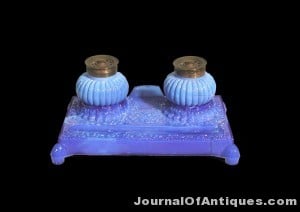
Boston & Sandwich Glass Co.
Sandwich, MA, circa 1830
Length: 6 7D8 inches
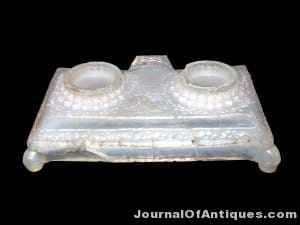
Boston & Sandwich Glass Co.
Sandwich, MA, circa 1830
Length: 6 7D8 inches; Museum purchase
In 1981 author Jane Shadel Spillman, Curator of American Glass at the Corning Museum of Glass, chose to feature an opaque blue Sandwich glass desk set as the cover illustration for her comprehensive book American and European Pressed Glass in the Corning Museum of Glass. Only six examples of the desk set were known at that time. Several more have turned up since, including the example show here from the NBMOG collection. The set features a pressed glass tray and two separate mold-blown bottles for ink and blotting sand. It is attributed to Sandwich on the basis of shards excavated at the Sandwich factory site. The set dates to about 1830, and the tray is important as an ambitious, early product of the glass press, which was invented about 1826 for making drawer pulls. The upper surface of the tray sports an embossed basket-of-flowers decoration and a small recession meant to hold a pen. The NBMOG example was donated by Mrs. Robert Fairbairn, and in 2004 the museum also acquired what is currently the only known example of the tray in opalescent glass. It had been excavated in several pieces from a privy in South Boston, but, unfortunately, matching bottles were never found. The hunt is on!
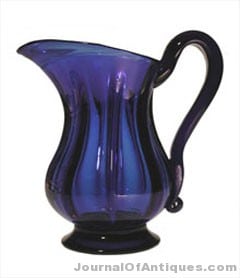
Prob. Pittsburgh, PA area; circa 1860
Height: 9 3D8 inches; Museum purchase
Canary Pillar-Molded
Decanter
Prob. Pittsburgh, PA area; circa 1860
Height: 12 1D8 inches; Museum purchase
Collector and long-time Pittsburgh resident Lowell Innes illustrated numerous examples of pillar-molded glass in his book Pittsburgh Glass 1797-1891 (Boston: Houghton Mifflin Co., 1976). Innes claims that pillar-molded glass was a favorite for use on the frontier, and could be found “on every elegantly appointed paddle-wheel boat that plied the Western rivers.” According to the author, the glass was referred to as “riverboat glass.” “By its sturdiness and pleasantly rounded lines,” he writes, “pillar-molding possessed a dignity inherent in middle-class America. Examples of pillar-molding turn up today anywhere along the great valley from Pittsburgh to the Gulf of Mexico. Dealers, collectors, and authorities unite in declaring that these pieces belong to Pittsburgh.” To support the Pittsburgh attribution, Innes refers to numerous illustrations from trade catalogs issued by the firm of M’Kee and Brothers between 1859 and 1871. He also illustrates examples with a distinctive casing of colorless glass over opal, and cites an important compote that descended in the glassmaking Bakewell family of Pittsburgh.
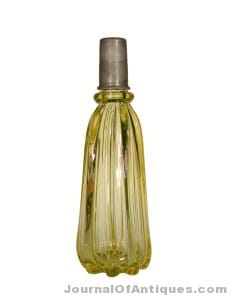
Strong evidence indicates that pillar-molded glass also was produced by New England factories. Vases can be found with pillar-molded tops joined to pressed base designs attributed to Sandwich. Additionally, a photograph of the display by the Mt. Washington Glass Company of New Bedford, Massachusetts, at the 1876 Centennial Exhibition in Philadelphia clearly shows several pillar-molded glass pitchers.
Pillar-molded glass is rare in color, and the New Bedford Museum of Glass is fortunate to have three exceptionally fine examples in its collection. One of these, an amethyst pitcher, has been embellished by the application of white glass threads along the ribs. This was achieved by placing pieces of white glass cane into the mold before the hot glass was inserted to form the ribs. Related examples are known in colorless glass with blue threads. The museum’s canary pillar-molded decanter has a pewter cup-shaped cover that Innes describes as a “jigger” slip stopper. This decanter is exciting for its rare color, and also because it came from Innes’s personal collection, which was sold at auction in_1986.

Cape Cod Glass Co.
Sandwich, MA; circa 1865
Height: 6 3D4 inches; Museum purchase
Following a dispute in 1858 with his company’s Board of Directors, Deming Jarves, the founder of the Boston & Sandwich Glass Company, left to start a rival company named the Cape Cod Glass Works. Later incorporated as the Cape Cod Glass Company, the new operation was successful for a period of about ten years. It shut down on April 15, 1869, and a local newspaper report shows that Deming Jarves died at age 78 that same day. Jarves had taken many of his workers with him to the new factory. One of these, James Danforth Lloyd, was responsible for mixing the glass ingredients and developing new colors. Lloyd is given credit for creating the bright ruby red glass made in Sandwich, and the example illustrated here was acquired by NBMOG directly from a Lloyd descendent. It’s important family history is permanently documented by the engraved initial “L” for Lloyd that ornaments its side. The Lloyd family cigar holder has been known to collectors for many years. Kenneth M. Wilson illustrated it on page 335 of his landmark study New England Glass and Glassmaking (Sturbridge, MA: Old Sturbridge Village, 1972). More recently it was featured as the cover illustration of A Guide To Sandwich Glass: Cut Ware, a General Assortment and Bottles by Raymond E. Barlow and Joan E. Kaiser (Atglen, PA: Schiffer Publishing Ltd., 1999). Interestingly, these authors were compelled by damage to the cigar holder’s foot (subsequently restored) to show only the reverse side of the piece. For this reason, the engraved initial “L” is not visible, and is illustrated here for the first time. The Lloyd family cigar holder has been admired for its beautiful color and its distinctive cut decoration, but, most importantly, it has been treasured for its connection to James Lloyd and, through Lloyd, to the legendary figure of Deming Jarves.
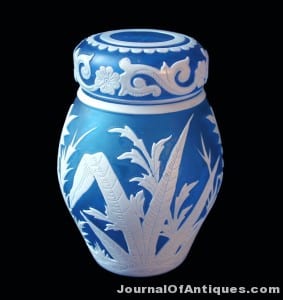
Attributed to Gillinder & Sons
Philadelphia, PA, 1886-1887
Height: 4 7D8 inches
Last fall the staff of the New Bedford Museum of Glass showed this covered jar to Susie Jacobson and Phil Edelman of Leo Kaplan Ltd. in New York. At the time, it was thought to be an unfinished example of cameo glass by the English firm of Thomas Webb & Sons. Both Ms. Jacobson and Mr. Edelman questioned the attribution and recommended sending photographs to Kelsey Murphy, whose career as a contemporary cameo glass artist includes a long and productive association with the Pilgrim Glass Company of Huntington, West Virginia. Following the close of Pilgrim in 2001 and a brief tenure with the Fenton Art Glass Company of Williamstown, West Virginia, Ms. Murphy focused on cameo production in her own studio, which she runs in East Lynn, West Virginia, with partner Robert P. Bonkamp.
Ms. Murphy examined the photographs of the covered jar and made a startling suggestion. Could it be a product of Gillinder and Sons of Philadelphia, which experimented with cameo glass production in 1886 and 1887? Her suggestion is supported by comparison of the jar with eight examples of Gillinder glass illustrated in Susan H. Meyers’ article “Gillinder & Sons Cameo Glass,” published in the Glass Club Bulletin (Issue No. 161, Spring 1990, pp. 5-10). Only about a dozen such examples currently are known, most with histories of ownership in the Gillinder family. Together with the NBMOG jar, all show a relatively cursory approach to carved detail. The most common color plating combination is white glass over blue, and several of the attributed examples have a distinctive “grass” ground plane similar to that found on the NBMOG jar.
If the Gillinder attribution is correct, which seems likely, this covered jar represents an exciting discovery and an important contribution to the study of American art glass. It came to NBMOG as a gift from James B. Lessig in memory of Barbara M. Lessig.
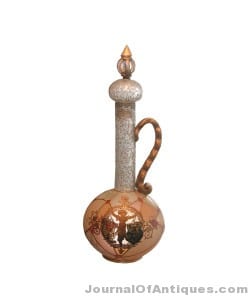
Mt. Washington Glass Co.
New Bedford, MA, circa 1890
Height: 18 3D8 inches
The Mt. Washington Glass Company relocated to New Bedford from South Boston in 1870. Today it is famous for its Victorian art glass, which included such well-known types as Amberina, Burmese, Peachblow, Crown Milano, and Royal Flemish. The Royal Flemish example shown here, a gift from the late Edie Lawson, represents the height of exuberance in decorated New Bedford glass. Royal Flemish was developed by decorating shop foreman Albert Steffin in 1888 and produced until the mid-1890s. Its background design was intended to suggest stained glass. For the definitive study on the subject, see Mt. Washington & Pairpoint Glass by Kenneth M. Wilson and Jane Shadel Spillman, published by the Corning Museum of Glass in 2011. Our NBMOG covered jug is illustrated on page 37!
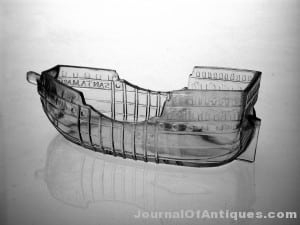
United States, circa 1893
Length: 7 inches
Statue of Columbus Bottle
United States, circa 1893
Height: 18 1D4 inches
American historical glass is defined as glass that relates specifically in design or decoration to American history. It has been popular since the beginning of the American antiques-collecting movement in the late 19th century. Pressed glass cup plates and mold-blown whisky flasks were early sub-categories, but commemorative glass, political campaign glass of all types, and World’s Fair glass soon joined the list. Author Bessie M. Lindsey wrote her comprehensive book 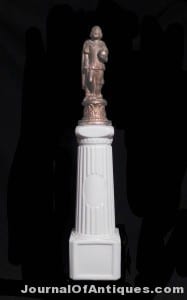
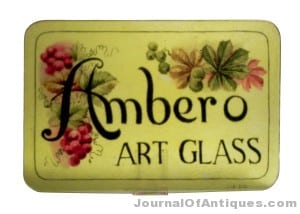
Pairpoint Corp.
New Bedford, MA; circa 1915
Length: 12 inches
Ruby Twist Comport
Pairpoint Corp.
New Bedford, MA; circa 1925
Diameter: 8 inches
Blue Twist Plate
Pairpoint Corp.
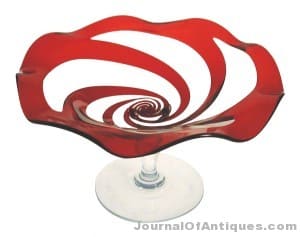
Diameter: 13 7D8 inches;
Museum purchase
In 1894 the factory of the Mt. Washington Glass Company became part of the Pairpoint Manufacturing Company, which was reorganized in 1900 as the Pairpoint Corporation. Pairpoint produced a highly successful line of reverse-painted lamps in the early 20th century, and was strongly influenced by popular Scandinavian styles in the 1920s and 1930s. One relatively early and distinctive line by the company was called Ambero. It features reverse-painted designs that take on a soft, hazy look when seen through the textured and acid-etched upper surface of the glass. The example shown here, an extremely rare advertising plaque, recently was donated to the museum by John Stewart and Candace Heublein. Two other highly distinctive Pairpoint lines were called Ruby Twist and Blue Twist. Examples were made by casing a colored layer of ruby or blue over colorless glass, cooling the cased form to room temperature in an annealing oven, grinding away part of the colored layer to create what would become the spiral pattern, and then reheating the glass to case it with an additional layer of colorless glass. Given the extremely involved process, it is not hard to imagine why relatively few 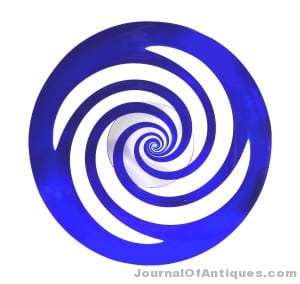
“Dropout” Vase
Frances Stewart Higgins
Riverside, IL; 1967
Height: 7 7D8 inches; Museum purchase
Square Dish
Higgins Glass, Dearborn Glass Co.
Bedford Park, IL, circa 1960
Length: 7 inches; Museum purchase
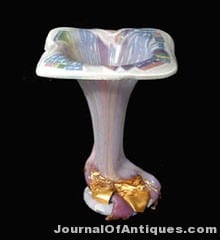
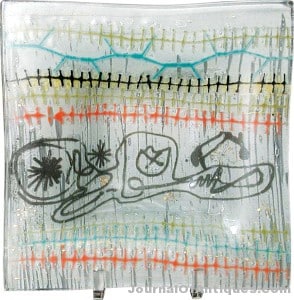
Frances referred to this type of vase as a “dropout.” Johnson and Piña describe the technique in their book. “First,” they write, “the desired assembly of glass is placed on a clay ring-mold. Glass circles of slightly different diameters are used, so that after fusing they make a single edge. As it is heated, the glass sags through and spreads a bit over the shelf of the kiln. When the intended form has been achieved, the kiln is opened and the dropout shape is ‘frozen.’”
Like the dropout vase, the square Higgins dish with the linear design was purchased by NBMOG at the Higgins estate sale in 2004. It had been featured on the cover of the catalog for the “Fifty / 50” exhibition held in New York City in 1985, and also had been illustrated on the first page of the “In the Studio” chapter in the Johnson & Piña book. We subsequently learned from the authors that actual chicken wire was dipped into colored enamel and touched to the glass to achieve that part of the design.
The New Bedford Museum of Glass is a 501 (c) (3) tax-exempt organization. It is open to the public seven days a week. Hours are Monday-Saturday from 10am-5pm, Sunday from noon to 5pm, and Thursday evenings from 5-8PM. Admission is $5.00. For directions and information about membership and volunteer opportunities, or to inquire about consigning items to the museum’s shop, please send an email to knelson@nbmog.org. or visit the museum online at www.nbmog.org.



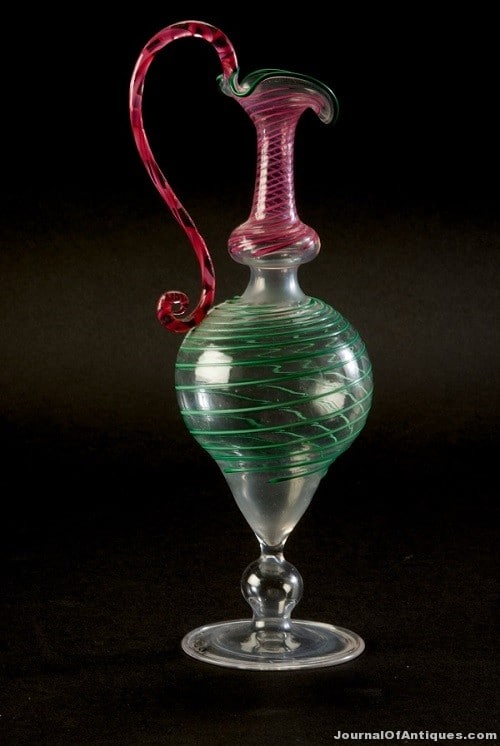




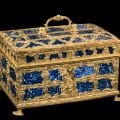


Pingback: Journal of Antiques and Collectibles April 2013 Issue | The Journal of Antiques and Collectibles